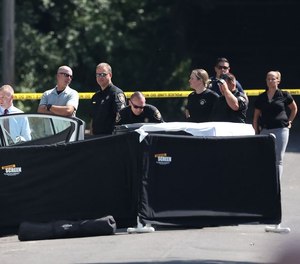By Tim Knauss
syracuse.com
SYRACUSE, N.Y. — The Onondaga County Sheriff’s Office is working to fix delays, poor planning and miscommunication that have plagued its $2.5 million system of body cameras and dashboard cameras since they were bought 18 months ago.
A deputy’s deadly shooting of two teenagers last month exposed the department’s camera failures. To the shock of many, neither the deputy’s body camera nor his dash camera was turned on during the incident.

Onondaga County sheriffs at the scene of a shooting on Mooney Ave in Syracuse. (Dennis Nett/syracuse.com)
Sheriff Toby Shelley, who took office in January, said his administration has been working for months to organize a half-finished camera system inherited from the previous sheriff, Eugene Conway.
“It’s a work in progress,’’ Shelley said.
Shelley’s team is working to strengthen policies put in place when the body cameras arrived last year. And they just finished installing dashboard cameras that were delayed by supply-chain issues. Those efforts have been hampered by a lack of communication with the previous administration, Shelley said.
Matthew Fischer, the sheriff’s chief police deputy who is overseeing the camera program, said he was caught off guard when the dashboard cameras ordered during Conway’s term finally showed up a few months ago. He learned they had been ordered when a salesman asked where to deliver them.
Deputies still have not been trained on using the dash cams.
Now that all the equipment is in place, Fischer said he is putting together a new camera policy designed to ensure that incidents like the Sept. 6 shooting get recorded.
Beginning as early as next month, all 230 road patrol deputies will be retrained to activate their body cameras as soon as they are dispatched to a call, Fischer said. That directive will eliminate the ambiguity of the current policy, which says only to turn on the camera “upon engaging in a law-enforcement related activity.”
Shelley has emphasized that he does not blame Deputy John Rosello for not activating his camera before the fatal shooting Sept. 6. He said Rosello was faced with a chaotic, life-threatening situation when he fired at a stolen vehicle as it moved toward and then past him.
[RELATED: Video: N.Y. sheriff supports deputy after release of video in fatal shooting]
Bullets from Rosello’s gun killed two passengers — Lueth Mo, 15, and Dhal Apet, 17. Except for a silent, partially obscured video from a neighbor’s security camera 200 feet away, there was no video evidence of what happened.
Community activists have said the incident should not have resulted in the boys’ deaths. The state attorney general’s office is investigating whether the shooting was justified.
Nothing in the sheriff’s current camera policy specifies exactly when deputies should turn on their cameras.
The new policy will remove ambiguity and help ensure that deputies double-tap their cameras to start recording before they arrive at potentially volatile scenes, said Fischer, the chief police deputy. It may yield more useless video of travel time, but it will strengthen deputies’ “muscle memory’’ to activate the cameras for each call, he said.
“I’ll just turn it on and record my steering wheel for the six minutes it took me to get there. So be it,’’ Fischer said. “So be it.”
‘What are you even talking about?’
Shelley’s administration is revamping more than the body-cam training manual. Fischer said he has been working for months to address shortcomings in a camera system that was acquired last year but has been implemented in fits and starts.
The cameras were purchased at the initiative of the county executive, not the former sheriff. That origin may account for some of the reversals and delays in putting the system to work.
County Executive Ryan McMahon persuaded legislators to fund the cameras in 2021 after former Sheriff Conway said his office could not afford them and indicated they were not a priority. After Axon Enterprise won the request for proposals, the county entered a five-year, $500,000-a-year contract for body cameras, dashboard cameras and associated equipment.
Conway retired at the end of 2022. Before he did, his office returned for credit some of the equipment bought by the county – sensor devices that automatically activate the cameras when a deputy removes a firearm or Taser from its holster. Fischer said he plans to obtain those sensors but has not ordered them yet.
Other parts of the system were hampered by poor communication.
The contract with Axon, which began May 1, 2022, included 70 in-car dashboard cameras along with 250 body cameras. Because of supply chain delays, the dashboard cameras were not delivered until April 2023, said Corinne Clark, speaking for Axon.
Fischer said he was not aware the county had ordered dash cams until mid-March, when an Axon representative told him they would be delivered soon.
“He was like, ‘Where do you want me to ship this stuff to?’ And I said, ‘What are you even talking about?’ … We had no documentation on that. So I’ve been playing catch-up from Day One,’’ Fischer said.
No policy had been written on using the dash cams, and no training for deputies had been developed.
“My personal opinion is, it wasn’t planned for,’’ Fischer said.
Former Sheriff Conway and his chief police deputy, Joseph Ciciarelli, did not return messages seeking comment.
Compliance is not monitored
Now that all the dash cams are in place, officials are working to integrate them with the body cameras so that activation of one will automatically turn on the other. That work is not completed yet, Fischer said.
Once the integration is done, Fischer plans to unveil a new use policy covering both types of cameras. He’s aiming for November. At that point, deputies will be retrained.
Daniel Zehnder, a camera consultant and trainer who worked 22 years in the Las Vegas Police Department, said officers should be given specific guidance so they activate their cameras by rote. The easiest method is to turn the camera on when dispatched to a call, he said.
Fischer said he wants to standardize the policy, so every deputy knows to activate the camera at the same time. Not only will that increase the number of events captured, but it will allow supervisors to monitor whether deputies are following the rules.
When it bought the cameras, the county bought add-on software that allows supervisors to compare the number of times deputies activate their body-cams with the number of calls they go on. That software is designed to monitor whether officers are using the cameras properly, according to Axon.
But supervisors at the sheriff’s office have not used the software to track compliance by deputies, Fischer said.
During a Sept. 20 interview, Fischer said he was uncertain whether the county had acquired the software, known as Axon Performance. Recently he confirmed that the county has the software but does not use it to monitor what percentage of calls result in camera activation.
Deputies have so much discretion under the existing body-camera policy that it would be difficult to hold them to account for failing to turn on their camera for most of their calls, Fischer said. Many calls ultimately turn out not to require video.
After the policy is changed to require activation upon dispatch, supervisors will be in a better position to monitor compliance by deputies, Fischer said.
“We want these cameras on,’’ Sheriff Shelley said last week at a neighborhood forum. “Our lives would be easier.”
A new contract
Efforts to shore up the sheriff’s camera systems have been underway for months. After discussions with Axon, the sheriff’s office is now proposing a new, 10-year contract with the company.
Fischer said he started talking with Axon representatives last winter because the sheriff’s office needs more Tasers, which Axon also supplies. Those discussions gradually expanded to the point that Fischer is now proposing a new contract to cover both Tasers and cameras.
The proposed deal would cost between $13 million and $15 million over 10 years, Fischer said.
That’s more than 2 ½ times what the county pays now for Tasers and cameras.
Part of the increased cost would be to more than double the number of Tasers (from 125 to about 325) to make them available to officers at the downtown jail and Jamesville penitentiary, Fischer said. The proposal also includes new services, including indoor drones and a dropbox that would allow citizens to supply photos or videos directly to the sheriff.
The sheriff’s office thus far has declined to make other details of the proposal public. Shelley has presented it to a few Republican legislative leaders. Legislature Chairman James Rowley declined to provide a copy.
McMahon, the county executive, has not seen the proposal yet, a spokesman said.
—
©2023 Advance Local Media LLC. Visit syracuse.com.
Distributed by Tribune Content Agency, LLC.


